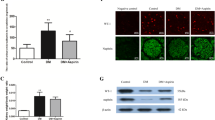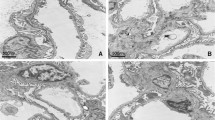Summary
To investigate the protective effects of eplerenone on adriamycin-induced renal injury and the possible mechanisms involved, 36 male Sprague-Dawley rats were randomly divided into control group, adriamycin nephropathy (AN) group and eplerenone-treated group (100 mg·kg−1·d−1 eplerenone). Blood pressure, 24-h urinary protein, serum potassium, sodium and creatinine were measured 28 days after adriamycin injection (a single tail intravenous injection of 6.5 mg/kg adriamycin). The morphological changes of renal tissues were observed by light and electron microscopy. Immunohistochemistry and Western blotting were performed to examine the expression of TGF-β1 and desmin in renal cortex. The results showed that 28 days after adriamycin injection, there were no significant changes in the level of serum potassium, sodium, creatinine concentrations and blood pressure values in the rats of the three groups. Meanwhile, the 24-h proteinuria excretion in the AN group was significantly higher than that in the control group (P<0.01), but that in the eplerenone-treated group was substantially reduced when compared with that in the AN group (P<0.05). Mild mesangial cell proliferation and matrix expansion, diffuse deformation and confluence of foot processes in podocytes were found in the AN group. By contrast, rats in the eplerenone-treated group exhibited obvious attenuation of these morphological lesions. The protein expression of TGF-β1 and desmin in the AN group was markedly up-regulated in contrast to that in the control group (P<0.01), whereas that in the eplerenone-treated group was much lower than in the AN group (P<0.05). It was concluded that eplerenone may ameliorate the proteinuria and the development of pathological alteration in adriamycin-induced nephropathy presumably via the inhibition of cytokine release, and restore the morphology of podocytes independent of its blood pressure-lowing effects.
Similar content being viewed by others
References
Nagase M, Fujita T. Aldosterone and glomerular podocyte injury. Clin Exp Nephrol, 2008,12(4):233–242
Kiyomoto H, Rafiq K, Mostofa M, et al. Possible underlying mechanisms responsible for aldosterone and mineralocorticoid receptor-dependent renal injury. J Pharmacol Sci, 2008,108(4):399–405
Guo C, Martinez-Vasquez D, Mendez GP, et al. Mineralocorticoid receptor antagonist reduces renal injury in rodent models of types 1 and 2 diabetes mellitus. Endocrinology, 2006,147(11):5363–5373
Nielsen FT, Jensen BL, Marcussen N, et al. Inhibition of mineralocorticoid receptors with eplerenone alleviates short-term cyclosporin A nephrotoxicity in conscious rats. Nephrol Dial Transplant, 2008,23(9):2777–2783
Lam EY, Funder JW, Nikolic-Paterson DJ, et al. Mineralocorticoid receptor blockade but not steroid withdrawal reverses renal fibrosis in deoxycorticosterone/salt rats. Endocrinology, 2006,147(7):3623–3629.
De las Heras N, Ruiz-Ortega M, Miana M, et al. Interactions between aldosterone and connective tissue growth factor in vascular and renal damage in spontaneously hypertensive rats. J Hypertens, 2007,25(3):629–638
Wolf G, Ziyadeh FN. Cellular and molecular mechanisms of proteinuria in diabetic nephropathy. Nephron Physiol, 2007,106(2):26–31
Yoshida S, Nagase M, Shibata S, et al. Podocyte injury induced by albumin overload in vivo and in vitro: involvement of TGF-beta and p38 MAPK. Nephron Exp Nephrol, 2008,108(3):e57–68
Iglesias-de la Cruz MC, Ziyadeh FN, Isono M, et al. Effects of high glucose and TGF-beta1 on the expression of collagen IV and vascular endothelial growth factor in mouse podocytes. Kidney Int, 2002,62(3):901–913
Fujisawa G, Okada K, Muto S, et al. Spironolactone prevents early renal injury in streptozotocininduced diabetic rats. Kidney Int, 2004,66(4):1493–1502
Juknevicius I, Segal Y, Kren S, et al. Effect of aldosterone on renal transforming growth factor-beta. Am J Physiol Renal Physiol, 2004,286(6):F1059–1062
Kerjaschkj D, Neale TJ. Molecular mechanisms of glomerular injury in rat experimental membranous nephropathy (Heymann nephritis). J Am Soc Nephrol, 1996,7(12): 2518–252
Author information
Authors and Affiliations
Corresponding author
Additional information
This project was supported by grants from the National Natural Sciences Foundation of China (Nos. 30500245, 30871174, and 31050110433), and a Medicine-technology Interdiscipline grant from Huazhong University of Science and Technology (No. 2010JC041).
Rights and permissions
About this article
Cite this article
Fang, Z., Zhang, C., He, F. et al. Protective effects of eplerenone on podocyte injury in adriamycin nephropathy rats. J. Huazhong Univ. Sci. Technol. [Med. Sci.] 31, 329–334 (2011). https://doi.org/10.1007/s11596-011-0376-5
Received:
Published:
Issue Date:
DOI: https://doi.org/10.1007/s11596-011-0376-5




